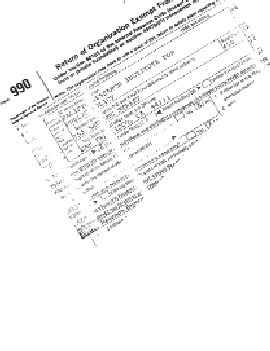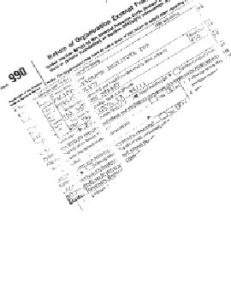Unlike commercial businesses, nonprofit organizations tend to operate at the edge of the public eye. There are no commercials or product announcements, and few publicists. Many nonprofits work on shoestring budgets to provide some sort of community.service and do not expect to make money. In exchange, California nonprofits do not have to pay federal or state income taxes. But sometimes creative means of makings ends meet can go awry. Whether a nonprofit’s mission and guidelines have fallen by the wayside or a financially successful organization proves too strong a temptation for some high-ranking employee, there are times when reporters will want to look behind the do-gooder façade of a nonprofit and examine its operations and finances.
For reporters investigating nonprofit organizations Form 990 and Form 990 Schedule A are gold mines of information. Form 990 is an annual report that nonprofit organizations are required to file with the Internal Revenue Service. It contains information about the nonprofit’s revenue, expenses, and net assets; names, salaries, and benefits of the five highest paid employees; names, addresses, and compensation of the five highest paid contractors; lobbying expenditures and activities; and a list of affiliated nonprofit or business organizations.
The application that an organization initially files for tax-exempt status, Form 1023 or 1024 (not analyzed in this article), must also be made available to the public under the same guidelines as a Form 990. Form 990 Schedule B, which lists the names of donors and their contributions, is not open to the public.
Obtaining a copy of the 990
There are several ways to get a copy of a 990–from the IRS, the Secretary of State’s Office (in California), or the nonprofit agency itself.
If the nonprofit is local, the fastest way to obtain a 990 is to walk into the organization’s office and ask for one. They must give you a copy to examine on the premises. If you waive that right and ask for a copy, they can charge you a reasonable photocopy fee–usually about 15 cents per copy. So, it’s a good idea to have about $25 in pocket when making the request. If the organization is out-of-town, the fastest way to get results is to send a written request for a copy to the agency. The request must be fulfilled within 30 days.
If a request for a copy of a 990 is made through the IRS, it will take a minimum of six weeks to deliver copies. There is no charge for members of the press, but the general public will be charged approximately $45.
Complaints against nonprofits that refuse to disclose their 990 can be sent to: Northern California Chapter, Chief Employee Plans and Exempt Organizations, 300 N. Los Angeles Street, Los Angeles, CA 90053. (This office only handles the Pacific Coast Region, but will forward any complaint to the appropriate regional office.)
Currently, the IRS is broadening the scope of a nonprofit’s accountability to the public under the Taxpayer Bill of Rights 2 (TBOR2). One of the complaints about access to financial documentation has been the “toothless” penalty against non-disclosure. Under the new regulations, an agency that does not furnish requested copies could be fined $20 per day, up to a maximum of $20,000 (IRS Code section 6104 (e)1a). In addition, nonprofit organizations’ financial documents will be made available on CD-ROM. However, the IRS hasn’t determined how or when they will be distributed. For information on where to find 990s online, and for more tips on how to read them access the Web addresses listed below.
The Money Flow What is the agency’s source of income, and how is it spent?
Parts I, II, and IV of the 990 present a general map of how
money flows through an organization.Page I, part I, lines 12, 17, and 21 show the organization’s total revenue, total expenses, and total net assets at the end of the year. The accompanying documents detail the type and amount of its holdings– investment securities, mutual funds, and interest earned.
Part IV of the 990 breaks down each type of holding (investment securities, land and equipment, grants) and compares their worth at the beginning of the year to their worth at the end of the year.
Part II breaks down the organization’s program, administrative, and fundraising costs for the year.
Part I of the 990 Schedule A shows the five highest paid employees (if they make over $50,000), their salaries, and benefits.
Online Resources
www.muridae.com/publicaccess/ for up-to-date information on nonprofit disclosure regulations and tips on making sense of the documents.
www.irs.ustreas.gov for IRS forms and instruction booklets.
www.nonprofits.org to locate a nonprofit organization anywhere in the United States.
Part IV-A of Schedule A provides a breakdown of the type of income the organization receives.
Part VI of Schedule A lists the overt lobbying expenditures made by the organization.
Mónica L. López is the assignment editor for ZDTV news.







